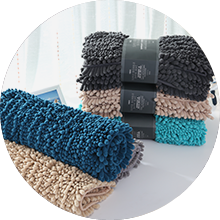1. The concept of printing and dyeing home textiles
The printing and dyeing technology, generally speaking, is to print and dye on textiles, so that the dyes can fully and thoroughly penetrate into the fabric, so that fresh and natural flowers, abstract geometric patterns, or patterns of different styles are formed in the fabric. Besides, enthusiastic, bright, and colorful colors can attract people's visual senses, enabling people to create passion, release emotions, and highlight individuality. Products with good printing and dyeing quality have vivid and lifelike patterns, and there is neither printing plate and color difference, nor dirt, discoloration, and other phenomena. Printing and dyeing are generally divided into reactive printing and dyeing and paint printing and dyeing. The cost of reactive printing and dyeing is high, but the advantage is that it does not fade; the cost of paint printing and dyeing is low, but the color fastness is not as stable as that of reactive printing and dyeing.
Printing and dyeing pigments are imported or domestically produced. Generally, printing and dyeing that does not contain azo and other carcinogens and heavy metals is called environmentally friendly printing and dyeing. At present, the Chinese government enforces the standard that textiles cannot contain substances that are harmful to human health. Manufacturers who violate the regulations will be severely fined or even suspended for rectification.
2. Classification of printing and dyeing of home textiles
(1) Pigment printing
Pigment printing for home textiles is a printing method in which insoluble pigments are fixed on the surface of the fabric by mechanical equipment (or manual printing) with the help of a binder, and then the pigments on the surface of the fabric are fixed by baking at a temperature of 102 to 104 degrees Celsius. The time is 5 to 6 minutes.
(2) Reactive printing and dyeing
Reactive printing and dyeing is a printing method that fixes reactive genetic dyes on fabrics. The dye is initially fixed on the fabric, and then it is completely fixed by steaming at 102 to 104 degrees Celsius, and the floating color is removed by high-temperature water (water temperature is about 60 to 90 degrees Celsius), so as to achieve the standard colorfastness.
Due to the needs of the market, some fabrics need to combine different weaving technologies and printing and dyeing technologies. There are various types of home textiles China fabrics on the market, including single-color fabrics, multi-color jacquard fabrics, single-color jacquard fabrics, yarn-dyed fabrics, jacquard + printed fabrics, colored fabric prints, and non-printed and dyed cotton fabrics.
3. Classification of home textiles printing
Printing can generally be divided into four categories: direct printing, discharge printing, anti-dye printing, and anti-print printing.
(1) Direct printing
Direct printing is a printing method that directly prints the printing paste on white or light-colored fabrics (the color paste does not react with the base color dye) to obtain a pattern. Features: simple technology, low cost, and wide application.
(2) Discharge printing
Discharge printing is a processing method in which the fabric is first dyed and then printed. It has two kinds of white discharge printing and colored discharge printing. Features: discharge printing can achieve the effect of full base color, fine pattern, and bright color, but the base color dye needs to be selected, and the printing technology of home textiles China is time-consuming and the cost is high.
(3) Anti-dye printing
Anti-dye printing is a processing method of printing first and then dyeing. Printing pastes contain chemicals that can destroy or prevent the dyeing of the base color. Features: the pattern obtained by anti-dye printing is generally not as fine as that of discharge printing, but the variety of applicable base color dyes is more than that of the former, and the printing technology also costs lesser time than that of discharge printing.
(4) Anti-print printing
Anti-print printing is a method of anti-dyeing or discharge printing by overprinting the base color on the printing machine. The choice of printing technology for home textiles should be comprehensively considered according to the fabric type, dye properties, printing effect, production cost, product quality requirements, and other aspects.

 Español
Español English
English русский
русский





